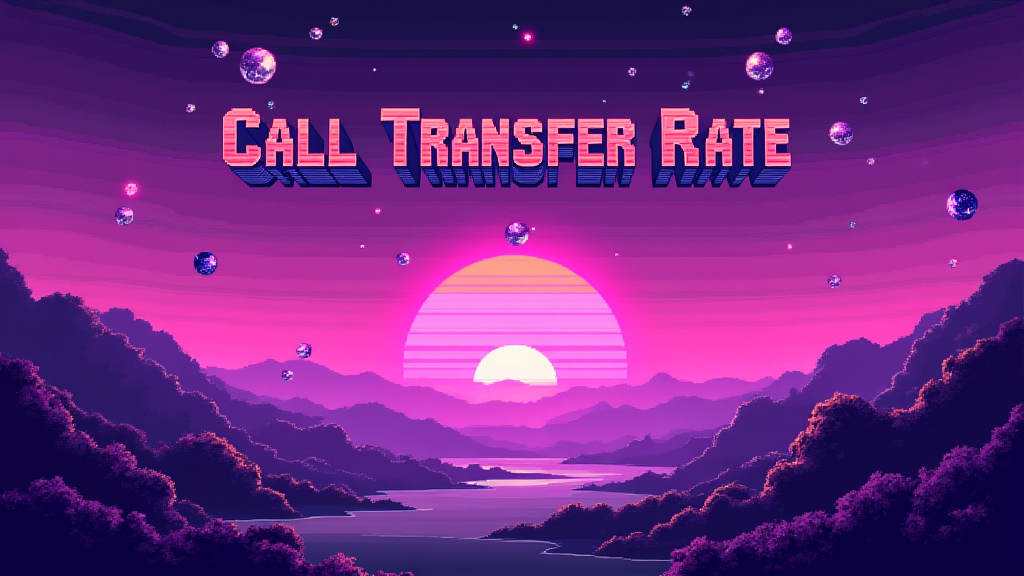Call Transfer Rate: Key Metric for Call Centers

Published on: October 01, 2024
In the world of customer service and call center operations, the Call Transfer Rate is a crucial metric that measures the percentage of incoming calls that are transferred to another department or representative. This key performance indicator (KPI) provides valuable insights into the efficiency and effectiveness of a call center's operations.
Understanding Call Transfer Rate 📞
The Call Transfer Rate is calculated using the following formula:
\[ \text{Call Transfer Rate} = \frac{\text{Number of Transferred Calls}}{\text{Total Number of Calls Handled}} \times 100\% \]
A lower Call Transfer Rate generally indicates better performance, as it suggests that agents are able to resolve customer issues without the need for transfers. However, it's important to note that some transfers are necessary and can lead to improved customer satisfaction when handled correctly.
Why Call Transfer Rate Matters 🎯
The Call Transfer Rate is significant for several reasons:
- Customer Experience: Fewer transfers often lead to higher customer satisfaction.
- Operational Efficiency: Lower transfer rates can indicate more efficient call routing and agent training.
- Cost Management: Reducing transfers can lead to shorter call times and lower operational costs.
- Agent Performance: This metric can help identify areas where agents may need additional training or support.
Benchmarking Call Transfer Rates 📊
While ideal Call Transfer Rates can vary by industry and company, here's a general benchmark to consider:
| Performance Level | Call Transfer Rate |
|---|---|
| Excellent | 0-10% |
| Good | 11-20% |
| Average | 21-30% |
| Poor | 31%+ |
Strategies to Improve Call Transfer Rate 💡
To optimize your call center's transfer rate, consider implementing these strategies:
- Enhanced Agent Training: Equip agents with comprehensive knowledge to handle a wider range of inquiries.
- Improved Call Routing: Implement intelligent routing systems to direct calls to the most appropriate agent from the start.
- Knowledge Base Optimization: Provide agents with easily accessible, up-to-date information to resolve customer issues quickly.
- Regular Performance Reviews: Analyze transfer patterns to identify areas for improvement and provide targeted coaching.
Common Challenges in Managing Call Transfer Rates 🚧
While striving to reduce Call Transfer Rates, organizations may face several challenges:
- Balancing transfer reduction with the need for specialized expertise
- Maintaining customer satisfaction during necessary transfers
- Implementing effective training programs without disrupting operations
- Accurately tracking and analyzing transfer data across multiple channels
By addressing these challenges and implementing targeted strategies, organizations can work towards optimizing their Call Transfer Rates and improving overall call center performance.
Integrating Call Transfer Rate into Your Operations Strategy
To effectively leverage the Call Transfer Rate metric in your Sales or Marketing Operations:
- Regularly monitor and analyze your Call Transfer Rate alongside other key metrics.
- Set realistic goals for improvement based on industry benchmarks and your organization's unique circumstances.
- Use the insights gained to inform agent training programs and call routing strategies.
- Consider the impact of Call Transfer Rate on customer satisfaction and overall operational efficiency.
By focusing on optimizing your Call Transfer Rate, you can enhance customer experience, improve operational efficiency, and drive better results for your organization.
As you consider implementing strategies to improve your Call Transfer Rate, ask yourself:
- How does our current Call Transfer Rate compare to industry benchmarks?
- What are the most common reasons for transfers in our call center?
- How can we empower our agents to handle a wider range of inquiries?
- What technologies or processes can we implement to reduce unnecessary transfers?
- How can we balance the need for specialized expertise with the goal of minimizing transfers?
For more insights, check out our articles on call abandonment rate and callback request rate.

















